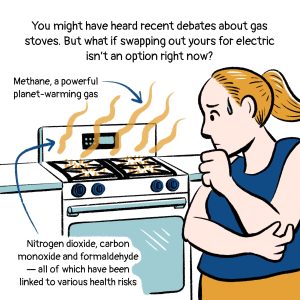Introduction
In today’s modern kitchens, gas stoves are a common feature. They provide efficient cooking but also pose a significant threat to indoor air quality and health due to the pollutants they emit. In this article, we’ll delve into the impact of gas stove pollution and explore effective strategies to reduce it.
Understanding the Impact of Gas Stove Pollution
Gas stoves emit various pollutants such as nitrogen dioxide and carbon monoxide, which can have adverse effects on health, particularly respiratory health. Prolonged exposure to these pollutants can lead to respiratory issues, exacerbate asthma, and even increase the risk of heart disease.
Health Risks Associated
The health risks associated with gas stove pollution are concerning. Nitrogen dioxide can irritate the lungs and lower resistance to respiratory infections, while carbon monoxide can impair the blood’s ability to carry oxygen, leading to dizziness, headaches, and even death in severe cases.

Tips for Reducing Pollution from Gas Stoves
Reducing pollution from gas stoves requires proactive measures to minimize emissions and improve indoor air quality. Here are some effective strategies:
Proper Ventilation
Proper ventilation is crucial for reducing gas stove pollution. Installing exhaust fans and opening windows while cooking can help remove pollutants and improve air circulation. Additionally, using a range hood with an external venting system can effectively capture and expel pollutants outdoors.
Regular Maintenance
Regular maintenance of gas stoves is essential to ensure they operate efficiently and emit fewer pollutants. Cleaning burners, vents, and exhaust fans regularly can prevent the buildup of carbon monoxide and other harmful gases. It’s also important to inspect gas lines for leaks and ensure proper installation to minimize emissions.
Opting for Cleaner Fuel Options
Switching to cleaner fuel options can significantly reduce pollution from gas stoves. Natural gas and propane are cleaner-burning fuels compared to traditional coal or wood, emitting fewer pollutants and particulate matter. Consider investing in a gas stove that is compatible with these cleaner fuel options to improve indoor air quality.

Importance of Indoor Air Quality
Indoor air quality plays a significant role in maintaining overall health and well-being. Poor indoor air quality can lead to a range of health issues, including respiratory problems, allergies, and asthma. By reducing pollution from gas stoves, we can enhance indoor air quality and create a healthier living environment for ourselves and our families.
Alternative Cooking Methods
Exploring alternative cooking methods can further reduce pollution from gas stoves and promote sustainable living. Here are two cleaner and more environmentally friendly alternatives:
Electric Stoves
Electric stoves are a popular alternative to gas stoves, offering cleaner and more precise cooking. They produce fewer pollutants and emissions, making them a safer option for indoor cooking. Electric stoves are also easier to clean and maintain, reducing the risk of indoor air pollution.
Induction Cooktops
Induction cooktops utilize electromagnetic technology to heat pots and pans directly, resulting in faster and more efficient cooking. They produce minimal emissions and heat, reducing energy waste and indoor air pollution. Induction cooktops are also safer to use, as they only generate heat when in contact with ferrous cookware, reducing the risk of burns and fires. Explore More About (Monkeypox Solution)

Creating Awareness in Communities
Educating communities about the importance of reducing gas stove pollution is essential for promoting sustainable living practices and protecting public health. By raising awareness about the health risks associated with gas stove pollution and providing practical tips for reducing emissions, we can empower individuals and communities to make informed choices and take action to improve indoor air quality.
| Factor | Gas Stoves | Electric Cooktops | Induction Cooktops |
|---|---|---|---|
| Emissions | Emit pollutants like CO and NO2 | Produce no emissions | Produce no emissions |
| Energy Efficiency | Moderate | Moderate | High |
| Temperature Control | Good | Good | Excellent |
| Cooking Speed | Fast | Moderate | Fast |
| Heat Distribution | Uneven | Even | Even |
| Safety | Risk of gas leaks, open flame | No risk of gas leaks, no open flame | No risk of gas leaks, no open flame |
| Installation | Requires gas line | Requires electrical connection | Requires electrical connection |
| Maintenance | Regular cleaning and inspection | Easy to clean, no special maintenance | Easy to clean, no special maintenance |
| Environmental Impact | Contributes to indoor air pollution | Minimal impact | Minimal impact |
| Cost | Moderate | Moderate | High |
Conclusion
In conclusion, gas stove pollution poses a significant threat to indoor air quality and public health. By implementing effective strategies such as proper ventilation, regular maintenance, and alternative cooking methods, we can reduce emissions from gas stoves and create a healthier living environment. It’s essential to prioritize indoor air quality and take proactive steps to minimize pollution from gas stoves for the well-being of ourselves and future generations.




